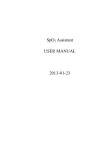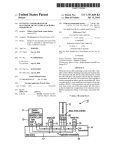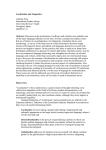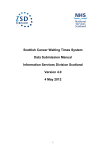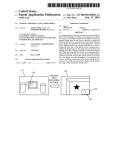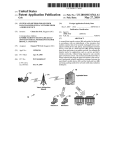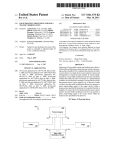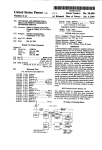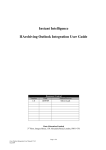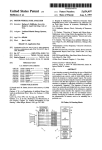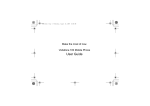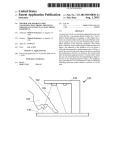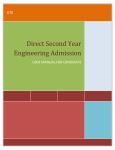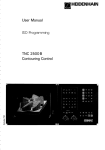Download Evaluation of substitution contexts
Transcript
US 20140365515A1 (19) United States (12) Patent Application Publication (10) Pub. No.: US 2014/0365515 A1 Garrett et al. (54) (43) Pub. Date: EVALUATION OF SUBSTITUTION (52) Dec. 11, 2014 U.S. Cl. CONTEXTS CPC .............................. .. G06F 17/30967 (2013.01) USPC ........................................................ .. 707/759 (71) Applicant: Google Inc., Mountain View, CA (U S) (72) Inventors: Zachary A. Garrett, Tokyo (JP); Takahiro Nakajima, Chiba (JP); Akira (57) ABSTRACT Ishino, Tokyo (JP) (73) Assignee: G 0 Ogle Inc” Mountain View, CA (Us) Methods, systems, and apparatus, including computer pro (21) App1_ NO; 13/961,200 grams encoded on computer storage media, for evaluating substitute terms. One of the methods includes receiving a query and identifying an original term occurring in the query. (22) Filed: (60) Aug. 7, 2013 One or more substitution contexts are determined for the original term, Wherein a substitution context includes one or more context terms and an indication of a position in the Related U-s-APPllcatlon Data Provisional application No. 61/833,332, ?led on Jun. 10, 2013~ query Ofthe Original term and the one or more come“ terms A score is determined for each substitution context of the one or more substitution contexts. One or more substitution con Publication Classi?cation (51) texts are selected based on the score of each substitution context. One or more substitute terms for the original term in the context of the one or more selected substitution contexts Int. Cl. G06F 17/30 (2006.01) are determined. 1 00 \‘ 11% 112\ 116\ Process0r(s) | 1 Input Module f, ’/ I Client 110 Device 1 1 3\ D'sp'ay Computer Readable Media 114\ 117\ Communication Software interface \ Applications 105/Original Query ® Search Results Page ® 1 55 130\ “ “ “1 Search System 170\ . . /105 Original Query Query Reviser 115 En me Original I 9 ® ReVIsed Queries 1Query erms © r140 Search System Front-end ® © K125 K 135 All Queries Synonyms 137) Substitute Term Engine / 180 185 Search Results . Search Engine K 160 Query Substitution |ndex Database Rules Database Database 150 145 Patent Application Publication Dec. 11, 2014 Sheet 1 of 7 US 2014/0365515 A1 100 N 112\ Processor(s) 112m 118\ , Dis la Cllent110 p y Device '7 116\ Input Module Computer _ 7' ., Readable Media 117\ 114\ \ Communication Software Interface Applications /Original Query 105 Search Results Page ® ® 130\ 155 “ Search System 170\ Orrgrnal/ . Query ‘ - ‘ ReVIser 115 En ine \ 9 Original Query Terms ©v . Query y K140 Search System _ “ 105 = Front-end ® ReVIsed ll Queries (F) @ 125 K135 All 8 non/ms Queries y y SUbsélr?gti?g-mm /180 137/ @ Search Results y 145 Search Engine 160 it Query Substitution |ndex Database D Rtuges Database \150 aa ase FIG. 1 Patent Application Publication Dec. 11, 2014 Sheet 2 0f7 US 2014/0365515 A1 .OEN wk f. . i“.. a: m 3 Patent Application Publication Dec. 11, 2014 Sheet 3 0f 7 Receive a query having an original term US 2014/0365515 A1 I310 V Determine substitution contexts for the original term I320 V Classify the substitution contexts into a first I330 category or a second category V Associate the original term with one or more I340 substitution contexts in the first category FIG. 3 Patent Application Publication Dec. 11, 2014 Sheet 4 0f7 mw mv \umwf. .,\i_., i! I . VH w m?w “me gmwmma“£m§E.m.wm. . Aa?nm bmw US 2014/0365515 A1 Patent Application Publication Dec. 11, 2014 Sheet 5 0f 7 US 2014/0365515 A1 mmm. .®m @me .mwm. w..me MW m am .wam %m m Patent Application Publication Dec. 11, 2014 Sheet 6 of 7 US 2014/0365515 A1 Identify an original term occurring in a received query V [5—620 Determine substitution contexts for the original term V [5—630 Determine a score for each substitution context i /\ / // \ 635 \ I </’ Dominant \—> N0 \ Select contexts ‘\ context? // \ / \\\\ /// Yes // / \\ j655 /// \ Yes // Contexts \\ t \\ agree? // N0 /_ t\\\v//// v 5 640 Select a highest-scoring v 5 660 Strengthen substitute terms substitution context ll 15-680 Determine substitute _ terms for original term in selected substitution contexts FIG. 6 ll Weaken substitute terms Patent Application Publication Dec. 11, 2014 Sheet 7 0f7 @WX ?gEif55%W.m\f.x Q.wmw“gmmEvAgwH“.mémth WWI“ W, US 2014/0365515 A1 Dec. 11, 2014 US 2014/0365515 A1 EVALUATION OF SUBSTITUTION CONTEXTS CROSS-REFERENCE TO RELATED APPLICATIONS [0001] This application claims the bene?t under 35 U.S.C. §1 19(e) of the ?ling date of Us. Provisional Patent Applica tion No. 61/833,332, ?led on Jun. 10, 2013, entitled “Evalu ation of Substitution Contexts,” the entirety of which is herein incorporated by reference. or actions means that the system has installed on it software, ?rmware, hardware, or a combination of them that in opera tion cause the system to perform the operations or actions. For one or more computer programs to be con?gured to perform particular operations or actions means that the one or more programs include instructions that, when executed by data processing apparatus, cause the apparatus to perform the operations or actions. [0007] The foregoing and other embodiments can each optionally include one or more of the following features, alone or in combination. Classifying a substitution context BACKGROUND into the ?rst category comprises determining a score for each [0002] This speci?cation generally relates to search engines, and one particular implementation relates to evalu and determining that the score satis?es a threshold. The actions include generating a context hierarchy of the one or more substitution contexts, wherein conditions of the parent context also apply to the child context, wherein determining a score for a substitution context comprises comparing a par ticular substitution context to its parent substitution context. A child context of a parent context in the context hierarchy includes an additional term that does not occur in the parent context. A child context of a parent context in the context ating substitution contexts for substitution rules that are used in revising search queries. [0003] To identify documents that are responsive to search queries, a search engine may match query terms, or substitute terms of the query terms, with terms that occur in the docu ments, or with terms that occur in metadata associated with the documents. SUMMARY [0004] Search systems use query revision engines to revise search queries, for example to include substitute terms of substitution context of the one or more substitution contexts; hierarchy includes one or more terms that have a class/in stance or category/obj ect relationship with one or more terms of the parent context. Determining a score for a substitution context comprises generating ?rst frequencies of occurrence query terms. To identify a substitute term of a query term, for alternate terms that occur in the substitution context in a query revisers evaluate candidate substitute terms according to various criteria, such as criteria that estimate whether, in a particular context, a candidate substitute term is a good sub textual collection; generating second frequencies of occur rence for alternate terms that occur in the parent substitution stitution of the query term. “Goodness” of a particular can context in the textual collection; and comparing the ?rst fre quencies of occurrence and the second frequencies of occur didate substitute term may be expressed, for example, by the amount of con?dence, trust, consistency, reliability, or other parent substitution context of the substitution context; deter characteristic that de?nes an association between a query term and the candidate substitute term. [0005] A system can evaluate a substitution context asso ciated with an original term based on whether the substitution rence. The actions include determining a ?rst score for a ?rst mining a second score for a secondparent substitution context of the substitution context; and selecting the minimum of the ?rst score or the second score. The actions include determin ing that at least one substitution context is classi?ed in the ?rst category; and in response to determining that at least one context adds signi?cant meaning to the original term. Good substitution contexts are meaningful and useful in that they help to disambiguate the meaning of the original term when substitution context is in the ?rst category, classifying the general context into the second category. The actions include choosing substitute terms. Bad substitution contexts, on the determining that no substitution contexts are classi?ed in the other hand, do little to disambiguate the meaning of the origi ?rst category; and in response to determining that no substi tution contexts are in the ?rst category, classifying the general context into the ?rst category. Associating the original term nal term, introduce noise into the system, and can cause the system to generate unreliable substitute terms. The system can discard bad contexts before generating substitution rules, “of?ine” evaluation, and the system can select a number of the best substitution contexts at query revision time, “online” evaluation. [0006] In general, one innovative aspect of the subject mat ter described in this speci?cation can be embodied in methods that include the actions of receiving a query having an original to a substitute term generation process that generates substi tute terms for the original query term. Particular embodi ments of the subject matter described in this speci?cation can term; determining one or more substitution contexts for the original term, wherein a substitution context includes one or more context terms and an indication of a position in the query of the original term and the one or more context terms; classifying the substitution contexts into a ?rst category or a second category based on a respective score of each substi makes the size of the substitution rule data smaller. Addition tution context; and associating the original term with one or more substitution contexts in the ?rst category. Other with one or more substitution contexts in the ?rst category comprises providing substitution contexts in the ?rst category be implemented so as to realize one or more of the following advantages. Classifying substitution contexts as good or bad can improve the quality of substitution rules generated. Dis carding bad contexts makes statistics calculation faster by eliminating data collection for bad contexts, which also ally, removing bad contexts improves substitution rule accu racy, as bad contexts may introduce unreliable or spurious substitute terms or incorrectly indicate that a substitute term is a bad substitute term. embodiments of this aspect include corresponding computer [0008] systems, apparatus, and computer programs recorded on one or more computer storage devices, each con?gured to per matter described in this speci?cation can be embodied in methods that include the actions of receiving a query; identi form the actions of the methods. For a system of one or more fying an original term occurring in the query; determining computers to be con?gured to perform particular operations one or more substitution contexts for the original term, In general, another innovative aspect of the subject Dec. 11, 2014 US 2014/0365515 A1 wherein a substitution context includes one or more context [0010] terms and an indication of a position in the query of the original term and the one or more context terms; determining described in this speci?cation can be implemented so as to realize one or more of the following advantages. Classifying substitution contexts as good or bad can improve the quality a score for each substitution context of the one or more substitution contexts; selecting one or more substitution con texts based on the score of each substitution context; and determining one or more substitute terms for the original term in the context of the one or more selected substitution con texts. Other embodiments of this aspect include correspond ing computer systems, apparatus, and computer programs recorded on one or more computer storage devices, each con?gured to perform the actions of the methods. Particular embodiments of the subject matter of substitution rules generated. Discarding bad contexts makes statistics calculation faster by eliminating data collec tion for bad contexts, which also makes the size of the sub stitution rule data smaller. Additionally, removing bad con texts improves substitution rule accuracy, as bad contexts may introduce unreliable or spurious substitute terms or incorrectly indicate that a substitute term is a bad substitute term. [0011] The details of one or more embodiments of the subject matter of this speci?cation are set forth in the accom [0009] The foregoing and other embodiments can each optionally include one or more of the following features, panying drawings and the description below. Other features, alone or in combination. Selecting one or more substitution contexts based on the score of each substitution context com aspects, and advantages of the subject matter will become apparent from the description, the drawings, and the claims. prises selecting a highest-scoring substitution context. BRIEF DESCRIPTION OF THE DRAWINGS Selecting one or more substitution contexts based on the score of each substitution context comprises classifying the substi [0012] tution contexts into a ?rst category or a second category based revise queries using substitute terms. on the respective score of each substitution context; and [0013] FIG. 2 is a diagram of an example system that evalu ates substitution contexts for generating substitution rules. [0014] FIG. 3 is a ?ow chart of an example process for selecting substitution contexts in the ?rst category. The actions include generating a context hierarchy of the one or more substitution contexts, wherein conditions of the parent context also apply to the child context, wherein determining a score for a substitution context comprises comparing a par ticular substitution context to its parent substitution context. A child context of a parent context in the context hierarchy includes an additional term that does not occur in the parent context. A child context of a parent context in the context hierarchy includes one or more terms that have a class/in stance or category/object relationship with one or more terms of the parent context. Determining a score for a substitution context comprises comparing a particular substitution con text to the general context; and computing a combined score using the comparison of the particular substitution context to the general context and the comparison of the particular sub stitution context to the general context. Determining a score for a substitution context comprises generating ?rst frequen cies of occurrence for alternate terms that occur in the sub stitution context in a textual collection; generating second frequencies of occurrence for alternate terms that occur in the parent substitution context in the textual collection; and com paring the ?rst frequencies of occurrence and the second frequencies of occurrence. The actions include determining a FIG. 1 is a diagram of an example system that can evaluating substitution contexts for generating substitution rules. [0015] FIG. 4 is a diagram of an example context hierarchy. [0016] FIG. 5 is a diagram of an example system that evalu ates substitution contexts for query revision. [0017] FIG. 6 is a ?ow chart of an example process for evaluating substitution contexts for query revision. [0018] FIG. 7 is a diagram of an example context hierarchy. [0019] Like reference numbers and designations in the various drawings indicate like elements. DETAILED DESCRIPTION [0020] FIG. 1 is a diagram ofan example system 100 that can revise queries using substitute terms. In general, the sys tem 100 includes a client device 110 coupled to a search system 130 over a network 120. The search system 130 includes a search engine 150, a query reviser engine 170, and a substitute term engine 180. The search system 130 receives a query 105, referred to by this speci?cation as the “original search query” or an “initial query,” from the client device 110 over the network 120. The search system 130 provides a ?rst score for a ?rst parent substitution context of the substi tution context; determining a second score for a second parent search results page 155, which presents search results 145 identi?ed as being responsive to the query 105, to the client substitution context of the substitution context; and selecting device 110 over the network 120. the minimum of the ?rst score or the second score. The actions include computing a score between two of the identi?ed by the search system 130 can include one or more selected substitution contexts that represents how closely the substitution contexts agree; determining, based on the score, that the substitution contexts do not agree; and in response to determining that the substitution contexts do not agree, decreasing a weight given to substitute terms for the original term generated using the substitution contexts that do not agree. The actions include computing a score between two of the selected substitution contexts that represents how closely the substitution contexts agree; determining, based on the score, that the substitution contexts agree; and in response to determining that the substitution contexts agree, increasing a weight given to substitute terms for the original term gener ated using the substitution contexts that agree. [0021] In some implementations, the search results 145 search results that are identi?ed as being responsive to queries that are different than the original search query 105. The search system 130 can generate or obtain other queries in numerous ways, e.g., by revising the original search query 105. [0022] In some implementations, the search system 130 can generate a revised search query by adding to the original search query 105 additional terms that are substitute terms of one or more terms that occur in the original search query 105. In other implementations, the search system 130 can generate a revised search query by substituting terms that are substitute terms of terms that occur in the original search query 105, in place of the terms in the original search query 105. As used by Dec. 11, 2014 US 2014/0365515 A1 this speci?cation, “substitute terms,” or other terms used to generate revised search queries, can also be referred to as a original term “drive” in the query, e.g. “how to drive a car.” Similarly, [how to : a] is an example notation for a left and “synonyms.” Additionally, a “substitution rule” can also be referred to as a “synonym rule.” The substitute term engine right adjacent context for the original term “drive” that speci ?es both terms to the left, “how to,” and right, “a,” of the 180 can determine the additional terms that are candidate substitute terms for the one or more terms that occur in the original term in the query. [0027] Contexts can also be ?oating contexts that de?ne original search query. The query reviser engine 170 can gen erate the revised search query. The search engine 150 can use the original search query 105 and the revised queries to iden tify and rank search results. The search engine 150 can pro vide the identi?ed search results 145 to the client device 110 on the search results page 155. [0023] The substitute term engine 180 can identify the sub stitute terms that the query reviser engine 170 can use to generate revised queries by evaluating terms included in pre viously received queries stored in a query database 190. The queries stored in the query database 190 can include previous queries in which a user considered the results of the queries desirable. For example, the user can click the provided search results from a query, in effect, validating the search results. The queries stored in the query database 190 can include previous queries determined to provide desirable results by the search system 130. For example, the search system 130 can perform a quality thresholding for returned search results one or more terms that co-occur anywhere in the query. Float ing contexts can be speci?ed by a “< >” notation. For example, <to > speci?es that the term “to” co-occurs with the original term somewhere in the query, and <how to > speci?es that the phrase “how to” co-occurs with the original term somewhere in the query. [0028] A special context [z], which may be referred to as the “general context,” if associated with a substitution rule, indi cates that the substitution rule can apply regardless of other terms co-occurring with the original term or not in the query. For example, the substitution rule having the general context “manual->automatic [:]” indicates that “manual” can be replaced by “automatic” regardless of whether other terms co-occur with manual in the query. On the other hand, the substitution rule “manual->automatic [: car]” indicates that “manual” can be replaced by “automatic” only if the original term “manual” is followed by “car” in the original query. [0029] Multiple distinct substitution rules can generate the from a query. The quality thresholding can include determin ing search results that have historically been returned for a particular query, and ?ltering those results that do not satisfy the query term “dog” in the query “dog food,” the term “pet” predetermined quality criteria. Search results above the qual can be designated as a substitute term for “dog” by both a ity threshold can validate a query, which the search system 130 can then include in the query database 190. substitution rule for “dog” in the general context “[:]” as well as a substitution rule for “dog” when followed by “food,” or [0024] Given a ?rst original term, e.g. “cat,” the substitute term engine 180 can evaluate terms, e. g. “feline” or “banana,” that are candidate substitute terms for the original term. In addition, the substitute term engine 180 can designate certain terms as substitute terms of the ?rst term, as in the case of “feline,” and can designate other terms as not substitute terms of the ?rst term, as in the case of “banana.” The substitute term engine 180 can base these determinations on rules stored in a substitution rules database 185. Two example substitution rules can be that “feline” is a substitute term for “cat” and “banana” is not a substitute term for “cat”. In this speci?ca tion, although some examples may refer to one or more sub stitute terms for an original term, an original term of a sub stitution rule may include multiple terms. For example, a substitution rule may designate “SF” to be a substitute term for the original term “San Francisco.” [0025] The search system 130 can de?ne substitution rules to apply generally, or to apply only when particular condi tions, or “substitution contexts,” are satis?ed. A “substitution context,” or for brevity, “context,” de?nes one or more terms that co-occur in the query with the original term as well as a same substitute term for a given query term. For example, for “[: food]”. Furthermore, a substitution rule need not apply in all situations. For example, when the term “cats” is used as a single-term query, the term “felines” can be considered a substitute term for “cats”. But when the query includes the term “cats” followed by the term “musical,” the system may not use “felines” as a substitute term for “cats.” In some implementations, the substitution rules can be stored in the substitution rules database 185 for use by the substitute term engine 180, the query reviser engine 170, or the search engine 150. [0030] In the illustrative example of FIG. 1, the search system 130 can be implemented as computer programs installed on one or more computers in one or more locations that are coupled to each other through a network, e.g., net work 120. The search system 130 includes a search system front end 140, e.g., a “gateway” or “proxy” server,” that coordinates requests between other parts of the search system 130 and the client device 110. The search system 130 also includes one or more “engines”: the search engine 150, a query reviser engine 170, and the substitute term engine 180. [0031] The search system front-end 140, the search engine 150, the query reviser engine 170, and the substitute term engine 180 can be implemented on any appropriate type of computing device, e.g., servers, mobile phones, tablet com position in which the terms occur in the query relative to the original term. A substitution rule that includes a substitution context means that the original term must occur in the query as de?ned by the substitution context in order for the substi puters, notebook computers, music players, e-book readers, tution rule to apply. laptop or desktop computers, PDAs, smart phones, or other [0026] Contexts can be adjacent contexts that de?ne one or more terms that occur adjacent to the original term on either processors and computer readable media. Among other com side or both, e.g. to the left, or to the right. Adjacent contexts ponents, the client device 110 includes one or more proces stationary or portable devices, that includes one or more can be speci?ed by a colon notion in which a colon is a sors 112, computer readable media 113 that store software placeholder for a particular original term or corresponding substitute term. For example, [how to z] is an example nota tion for a left adjacent context for the original term “drive” applications 114, e.g., a browser or layout engine, an input that speci?es that the terms “how to” occur to the left of the module 116, e.g., a keyboard or mouse, a communication interface 117, and a display device 118. The computing device or devices that implement the search system front-end US 2014/0365515 A1 Dec. 11, 2014 140, the query reviser engine 170, and the search engine 150 original search query 105 to the query reviser engine 170. The may include similar or different components. query reviser engine 170 can generate one or more revised [0032] queries 135 based on the substance of the original search query 1 05. In some implementations, the query reviser engine 170 generates a revised search query by adding terms to the original search query 105 using substitute terms 125 for terms in the original search query 105. In other implementations, the query reviser engine 170 generates a revised search query In general, the search system front-end 140 receives the original search query 105 from the client device 110. The search system front-end 140 routes the original search query 105 to the appropriate engines included in the search system 130 so that the search system 130 can generate the search results page 155. In some implementations, routing occurs by referencing static routing tables. In other implementations, by substituting the substitute terms 125 for the corresponding routing occurs based on the current network load of an terms of the original search query 105. The query reviser engine 170 can obtain substitute terms 125 for use in revising the original search query 105 from the substitute term engine 180. [0038] During state C, the query reviser engine 170 com municates original search query terms 115 of the original search query 105 to the substitute term engine 180. The sub engine, in order to accomplish load balancing. In addition, the search system front-end 140 can provide the resulting search results page 155 to the client device 110. In doing so, the search system front-end 140 acts as a gateway, or interface, between the client device 110 and the search engine 150. [0033] Two or more of a search system front-end, a query reviser engine and a search engine, e.g., the search system front-end 140, the query reviser engine 170, and the search engine 150, respectively, may be implemented on the same computing device, or on different computing devices. Because the search system 130 generates the search results page 155 based on the collective activity of the search system front-end 140, the query reviser engine 170, and the search engine 150, the user of the client device 110 may refer to these engines collectively as a “search engine.” This speci?cation, however, refers to the search engine 150, and not the collec tion of engines, as the “search engine,” since the search engine 150 identi?es the search results 145 in response to the user-submitted query 105. [0034] In some implementations, the search system 130 can include many computing devices for implementing the functionality of the search system 130. The search system 130 can process the received queries and generate the search results by executing software on the computing devices in order to perform the functions of the search system 130. [0035] Referring to FIG. 1, during state A, a user of the client device 110 enters original search query terms 115 for the original search query 105, and the client device 110 com municates the original search query 105 to the search system stitute term engine 180 can use substitution rules included in the substitution rules database 185 to determine one or more substitute terms 125 for one or more of the original search query terms 115 of the original search query 105. [0039] The substitute term engine 180 communicates sub stitute terms 125 to the query reviser engine 170 during state D. The query reviser engine 170 generates one or more revised queries 135 by adding substitute terms 125 to the original search query 105. In addition, the query reviser engine 170 can generate one or more revised queries 135 by substituting certain terms of the original search query 105. [0040] The query reviser engine 170 communicates the one or more revised queries 135 to the search system front-end 140 during state E. The search system front-end 140 commu nicates the original search query 105 along with the one or more revised queries 135 to the search engine 150 as all queries 137 during state F. The search engine 150 generates search results 145 that it identi?es as being responsive to the original search query 105 and/or the one or more revised queries 135. The search engine 150 can identify search results 145 for each query using an index 160 that stores indexed documents, e.g., web pages, images, or news articles on the Internet. The search engine 150 can combine and rank the then pressing a search initiation button or control on the client identi?ed search results 145 and communicate the search results 145 to the search system front-end 140 during state G. [0041] The search system front-end 140 generates a search results page 155 that identi?es the search results 145. For example, each of the search results 145 can include, but are device 110. The client device 110 formulates the original not limited to, titles, text snippets, images, links, reviews, or search query 105, e.g., by specifying search parameters. The other information. The original search query terms 115 or the substitute terms 125 that appear in the search results 145 can be formatted in a particular way, e.g., in bold print and/or 130 over the network 120. For example, the user can submit the original search query 105 by initiating a search dialogue on the client device 110, speaking or typing the original search query terms 115 of the original search query 105, and client device 110 transmits the original search query 105 over the network 120 to the search system 130. [0036] Although this speci?cation refers to the query 105 as an “original” or an “initial” query, such reference is merely intended to distinguish this query from other queries, such as the revised queries that are described below. The designation of the original search query 105 as “original” is not intended to require the original search query 105 to be the ?rst query that is entered by the user, or to be a query that is manually entered. For example, the original search query 1 05 can be the second or subsequent query entered by the user. In another example, the original search query 105 can be automatically derived, e.g., by the query reviser engine 170. In another example, the original search query 105 can be modi?ed based on prior queries entered by the user, location information, and the like. [0037] During state B, the search system front-end 140 receives the original search query 105 and communicates the italicized print. For example, the search system front-end 140 transmits a document that includes markup language, e.g., HyperText Markup Language or eXtensible Markup Lan guage, for the search results page 155 to the client device 110 over the network 120 at state H. The client device 110 reads the document, e.g., using a web browser, in order to display the search results page 155 on display device 118. The client device 110 can display the original search query terms 115 of the original search query 105 in a query box, or “search box,” located, for example, on the top of the search results page 155. In addition, the client device 110 can display the search results 145 in a search results box, for example, located on the left-hand side of the search results page 155. [0042] FIG. 2 is a diagram of an example system that evalu ates substitution contexts for generating substitution rules. In general, the system receives a term in a query and generates Dec. 11, 2014 US 2014/0365515 A1 substitution rules only for contexts that are determined to be good. Bad contexts, on the other hand, are ?ltered out. Bad text hierarchy for the query 405 “how to drive a manual car” and the original query term 407 “manual.” The context hier contexts can be ?ltered out as a preprocessing step that elimi nates the need for the system to collect statistics on candidate substitution rules that apply in those contexts. One or more components illustrated in FIG. 2 can be part of a general a context and a link represents a parent-child relationship between contexts. In general, one context is a parent of another context, a child context, if conditions of the parent purpose substitute term engine, e.g. substitute term engine 180 of FIG. 1. [0043] In this example, a context enumerator 210 receives, from a query database 290, a term 205, “manual,” and a query 215, “how to drive a manual car,” in which the term 205 occurs. [0044] The context enumerator 210 uses other terms that co-occur with the term 205 in the query 215 to generate contexts 225 that can potentially be used to generate substi tution rules for the term 205. For the query 215, the context enumerator generates contexts [a 1], [drive a 1], [1 car], and [a 1 car]. [0045] A context classi?er 220 evaluates the contexts 225 in order to identify good contexts 235, which are passed on for evaluation by a substitution rule generator 230 as candidate substitution rules for the term 205. The substitution rule gen erator 230 will compute various statistical signals in order to archy includes nodes and links, in which each node represents context would also apply to the child context. For example, conditions of the parent context node 421 for [a 1], in other words, an “a” occurring before the term “manual,” would also apply for the child context node 431 [drive a 1], in other words, “drive a” occurring before the term “manual.” Similarly, con ditions of the parent context node 423 for <how> would also apply for child context node 433 for <how to >. [0051] Child contexts generally introduce additional infor mation from the parent context. For example, a child context can add an additional term from the parent context, e. g. the child context [drive a 1] introduces an additional term “drive” from the parent context [a 1]. A child context may also have a class/instance or category/ obj ect relationship with the parent context. For example, a parent context [city 1] may have a child context [yew york 1]. Some child contexts may intro duce information from the parent context in multiple ways, e.g., by both adding a term and by having a class/instance or determine which candidate substitution rules de?ned by (i) the term 205 and (ii) the good contexts 235 are strong enough category/ object relationship with the parent context. For to be stored as substitution rules 245 in a substitution rule database 285. In other words, bad contexts are ?ltered out and [new york city 1] the substitution rule generator 230 does not need to compute statistical signals for candidate substitution rules de?ned by the bad contexts. [0046] In this case, of the four enumerated contexts 225, the substitution rule generator 230 computes statistics for only the two best contexts, [1 car] and [drive 1 a]. The context classi?er 220 may determine that, for a particular term 205 and query 215, there are no good contexts. In such cases, the substitution rule generator 230 can compute statistical signals example a parent context [city 1] may have a child context [0052] Some context nodes have multiple parents, e.g. the context node 432 for [a 1 car] has both the parent node 421 for [a 1] as well as the parent node 422 for [1 car]. Some context nodes have multiple children, e. g. the context node 421 for [a 1] has both the child context node 431 for [drive a 1] and the child context node 432 for [a 1 car]. [0053] The system may generate a context hierarchy with all contexts up to a maximum complexity, where complexity is de?ned as the number of context terms in a particular only for the general context [1]. context. In FIG. 4, for example, the context hierarchy includes all contexts for the query 405 and the original query [0047] FIG. 3 is a ?ow chart of an example process for term 407 up to a maximum complexity of two terms, even evaluating substitution contexts for generating substitution though more contexts of higher complexity are possible, e.g. [how to drive a 1]. [0054] Referring back to FIG. 3, the system classi?es the rules. In general, a system receives a query and evaluates substitution contexts for an original term in the query to classify the substitution contexts as good or bad. The bad contexts can then be ?ltered out and the good contexts can be used to generate substitution rules for the original term. The process can be implemented by one or more computer pro substitution contexts into a ?rst category or a second category (330). The system can compare the contexts in the context hierarchy to determine which contexts are good because they add meaning to the original term in the query and therefore grams installed on one or more computers. The process will help to disambiguate the meaning of the original term and be described as being performed by a system of one or more which contexts are bad because they do not add meaning to computers, e.g. the substitute term engine 180 of FIG. 1. [0048] The system receives a query having an original term (310). For example, the system can receive the query “how to drive a manual car” having the original query term “manual.” The system can process queries stored in a query database in order to identify substitution rules for terms and phrases the original term and do little to disambiguate the original term. In general, the system compares parent and child nodes in the context hierarchy by computing a score that represents the relative usefulness of using the context of the child node instead of using the context of the parent node. In other words, occurring the queries. additional term of a child context adds meaning to the original term when choosing substitute terms of the original term. [0055] For example, the score between the node 410 for the general context [1] and the node 421 for [a 1] is low because [0049] The system determines substitution contexts for the original term (320). The system can enumerate all contexts for the original term using terms that co-occur in the query. The system can generate both adjacent contexts that de?ne terms occurring adjacent to the original term in the query, as well as ?oating contexts that de?ne terms that can occur the score represents a measure of how much including an using [a 1] instead of [1] adds little meaning to the original term “manual.” In other words, the intended meaning of “manual” and “a manual” is still ambiguous, as “manual” anywhere in the query. [0050] In some implementations, the system arranges the could refer to a stick shift car or to a user manual. contexts into a context hierarchy. FIG. 4 is a diagram of an for [a 1] and the node 431 for [drive a 1] is high because using [drive a 1] instead of [a 1] adds signi?cant meaning. In other example context hierarchy. FIG. 4 illustrates an example con [0056] On the other hand, the score between the node 421 Dec. 11, 2014 US 2014/0365515 A1 words, the intended meaning of “manual” becomes clearer by adding “drive” to the context because it is much more likely that the original term “manual” refers to a type of car. [0057] 14pm) (3) aeP,Q The system can classify contexts into a good cat egory and a bad category based on the computed score. For example, the system can classify contexts having a score that satis?es a threshold, e.g. 0.5, 0.7, or 0.9, as good contexts and can classify contexts having a score that does not satisfy the threshold as bad contexts. [0058] rpm) alternateisetidiff = Z [rp(a)><ln rqm) + 14pm) >< lnuqm) The system can compute a score between parent and child contexts in the hierarchy using a variety of criteria that are indicative of adding meaning to the original term. [0064] If the child context adds signi?cant meaning to the original term, the distribution in the textual collection of alternate terms is expected to be vastly different, resulting in a high alternate set difference. Therefore, the system can consider a high alternate set difference to be indicative of a good context. Alternatively, the system can compute a mea sure of similarity between the alternate sets, e.g. using a cosine or other vector similarity measure, and consider a high measure of similarity to be indicative of a bad context. [0059] One example criterion is an alternate set difference, [0065] Another example criterion for computing a score computed by comparing respective alternate sets between between a parent and a child context is an empty fraction rate. two contexts. An alternate set for a particular context is a set The empty fraction rate measures how often the original term and the terms of a particular context are the only terms in a of terms that commonly occur in the particular context. For the context [1 car], the alternate set includes terms that com monly occur immediately before “car,” e.g. “manual,” “stick shift,” and “fast.” The system can generate an alternate set for a substitution context by processing data in any appropriate textual collection, e.g. web documents, digitized books, or query databases, and generating a set of terms that occur most frequently in the particular context along with a measure of how frequently each alternate term occurs. [0060] The system can represent an alternate set using a vector in which each vector position corresponds to a particu lar term and the value of the corresponding position is a measure of frequency for the corresponding term. For query. The system can consider a child context to be a good context if the original term and the terms of the child context are often the only terms in a query. On the other hand, if the original term and the terms of the child context are more often joined by other terms in a query, the system can consider the child context to be unimportant. [0066] The system can compute an empty fraction rate for an original term and a context according to how often the original term and the context terms are the only terms in a query. The system can compute the empty fraction rate according to Equation (5). example, the system can compute a raw number of occur rences of each alternate term or a frequency of each alternate term among all alternate terms. [0061] (5) emptyiraction: C+ In some implementations, the system computes a “seen rate” and an “unseen rate” for each alternate term. A seen rate is a number of times the alternate term occurred in the context compared to the number of times the original term occurred in the context. For example, if the textual collection is queries, the seen rate can be given by Equation (1). QA (1) seenirate = — 0 [0067] Qc is a number of queries that contain only the original term and the context terms, and QC+is a number of queries that contain the original term, the context terms, and one or more other terms. In some implementations, the sys tem computes the empty fraction rate for the child context and determines whether the empty fraction rate of the child con text satis?es a threshold. If the empty fraction rate satis?es the threshold, the system can consider the child context to be a good context. If the empty fraction rate does not satisfy the threshold, the system can consider the child context to be a bad context. [0062] In Equation (1), QA is a number of queries in a collection that include the alternate term occurring in the context, and Q0 is a number of queries in the collection that include the original term occurring in the context. The unseen rate can be given by Equation (2). [0068] Another example criterion for computing a score between a parent and a child context is a comparison of histograms of co-occurring terms. The system can compute vectors of terms that co-occur in a textual collection with the (2) original term in the parent context and terms that co-occur in the textual collection with the original term in the child con After determining the alternate sets between two text. The system can then compute a difference vector between the two co-occurrence frequency vectors and evalu contexts in the context hierarchy, the system can compare the alternate sets to compute the alternate set difference. In some with the biggest co-occurrence frequency differences unseenirateII—seenirate [0063] implementations, the system computes the alternate set dif ference as a Kullback-Leibler divergence between the alter nate sets, which can be given by Equation (3) for alternate sets P and Q. In Equation (3), rp(a) is the seen rate of an alternate term a for the alternate set P, up(a) is the unseen rate of the alternate term a for the alternate set P, rq(a) is the seen rate of the alternate term a for the alternate set Q, and uq(a) is the unseen rate of the alternate term a for the alternate set Q. ate the term importance of a number N of co-occurring terms between the parent and child vectors. Good child contexts tend to have more meaningful words having the biggest co occurrence frequency differences, and bad child contexts tend to have less meaningful words, e. g. common words, with the biggest co-occurrence frequency differences. The system can compute a measure of importance of co-occurring terms according to any appropriate measure, e.g. an inverse docu ment frequency value over a textual corpus. The system can Dec. 11, 2014 US 2014/0365515 A1 then compute score for a number N of the most differently [0078] occurring terms weighted by corresponding measures of context 535 matches any substitution rules 545 in a substitu tion rules database 585 for the query term 505. The substitu tion engine 540 can use the query term 505 and best context 535 as a key to the substitution rules database 585, and in response, the substitution engine 540 can receive a set of importance. [0069] The system can select or combine any of the above mentioned criteria in any appropriate way to compute a score between a parent and child context. For example, the system can compute weights for each of the criteria that indicate an importance of each particular measure to compute the score as a weighted average. [0070] For child contexts that have multiple parents, e.g. the child node 432 for [a 1 car], the system may need to select The substitution engine 540 determines if the best substitute terms 555. In this example, substitute terms 555 for the original term 505 “manual” in the best contest 535 [1 car] are “stick shift,” “automatic,” and “manual transmission.” [0079] The substitution engine 540 can provide the result ing substitute terms 555 back to the query reviser engine 510 or combine scores from the two parents. The system can for generating revised queries. compute measures of central tendency for any of the statis [0080] FIG. 6 is a ?ow chart of an example process for evaluating substitution contexts for query revision. In gen tics, e.g. an arithmetic mean or geometric mean, a median, a mode, a minimum, or a maximum. [0071] After computing a score for each context in the context hierarchy, the system can classify each context as either a good context or a bad context, e.g. by comparing the score to a threshold. The system may alternatively select a eral, a system receives a term and a query and determines which substitution contexts for the term are good or bad. The process can be implemented by one or more computer pro grams installed on one or more computers. The process will be described as being performed by a system of one or more predetermined number or ratio of highest-scoring contexts to be good contexts and consider the remaining contexts to be computers, e.g. the substitute term engine 180 of FIG. 1. [0081] The system identi?es an original term occurring in a bad contexts. received query (610). [0072] The system associates the original term with one or more substitution contexts in the ?rst category (340). In gen eral, the system will discard bad contexts in the second cat egory, which causes the system not to compute substitute term statistics in the next stage of the substitute term pipeline. Instead, only good contexts will be eligible for evaluation and inclusion as substitute term rules. [0073] The system may determine that all child contexts in the context hierarchy are bad contexts. In those cases, the system can classify the only the general context into the ?rst category and associate the original term with only the general context [1]. In some implementations, if the system classi?es a single child context in the context hierarchy as a good context, the system does not associate the original term with the general context [1]. In other words, the system classi?es the general context into the second category, effectively dis carding the general context [1], and does not collect statistics for the general context in the next stage of the substitute term pipeline. [0074] FIG. 5 is a diagram of an example system that evalu ates substitution contexts for query revision. In general, the system receives a term in a query and generates substitute terms for a context that is determined to be the best context. The substitute terms generated can be passed to a query revision engine for performing online query revision, that is, after a query has been received from a user and before search [0082] The system determines substitution contexts for the original term (620). As mentioned above with reference to FIG. 3, the system can enumerate all adjacent and ?oating contexts for the original term using terms that co-occur in the query. The system can similarly arrange the enumerated con texts into a context hierarchy according to parent/child con text relationships. [0083] FIG. 7 is a diagram of an example context hierarchy. The context hierarchy in FIG. 7 is similar to the context hierarchy illustrated in FIG. 4, however, additional lines indi cate that additional scores are computed to compare some lowest-level contexts to the general context in order to com pare contexts that otherwise do not share a parent. [0084] Referring back to FIG. 6, the system determines a score for each substitution context (630). Again, the system can compute a score that represents a measure of how much including an additional term of a child context adds meaning to the original term when choosing substitute terms of the original term. The system can use similar scoring criteria as described above with reference to FIG. 3. [0085] For contexts with a complexity of two or greater, the system may only compare the context directly with the gen eral context during online evaluation. Thus, the system can compute an overall score for such contexts by combining the o?iine score for the context with the online score that com pares the context directly with the general context. For results have been provided to the user. [0075] A context enumerator 520 receives, from a query reviser engine 510, a term and a query 515 in which the term example, the system can choose the worst of the two or the best of the two. The system can compute a measure of central tendency, e. g. an arithmetic or geometric mean, between the o?iine and online scores, or the system can use a prediction 505 occurs. The context enumerator 520 uses other terms that model to compute a predicted score using both the o?iine and co-occur with the term 505 in the query 515 to generate contexts 525 that can potentially match substitution rules for the term 505 in a substitution rules database 585. online scores. [0076] As in the example above for FIG. 2, the context enumerator 510 can generate the contexts 525 [a 1], [drive a1], [1 car], and [a 1 car] for the query “how to drive a manual car.” [0077] A context evaluator 530 evaluates the contexts 525 in order to select one or more best contexts 535. In this [0086] In some implementations, the system classi?es the contexts as either good or bad using the combined overall score of the contexts, e.g. by comparing the overall score to a threshold. The system then discards the bad contexts so that only contexts that are classi?ed as good contexts remain to be used for query revision. [0087] The system can then compute a second score by example, the context evaluator 530 has determined that [1 car] comparing the remaining good contexts directly with the is the best context 535 and passes the selected best context general context. In other words, after choosing the good con texts, the system generates a ?nal ranking of the contexts in 535 to substitution engine 540. Dec. 11, 2014 US 2014/0365515 A1 terms of only the general context. For example, referring to FIG. 7, the system can discard all context nodes except for the nodes 731, 722, and 725. The system can then compute a ?nal ranking using the scores 702, 703, and 704 that compare the contexts to the general context. [0088] The system determines if there is a dominant sub stitution context (635). The system can determine if a highest scoring substitution context has a score that is signi?cantly re?ect a con?dence that particular substitute term is a reliable or trusted substitute for the original term. [0094] Thus, if the system determines that two substitution contexts agree, the system can consider substitute terms gen erated using those substitution contexts to be reliable and trusted. The system can therefore boost the IR score of docu ments that include occurrences of such reliable substitute higher than all other substitution contexts. For example, the terms by increasing the weight given to occurrences of the substitute terms in the documents. For example, the system system can determine if a highest-scoring substitution con text has a higher score than all other substitution contexts by may by default compute an IR score for a document by a particular margin, e.g. by either a particular raw numerical assigning a count of 1.0 to an occurrence of an original term and a count of 0.5 to an occurrence of a substitute term. If the score or as a measure of dominance over the other signals. If substitution contexts agree, the system can instead assign a so, the system can select a highest-scoring substitution con count of 0.75 to an occurrence of a substitute term generated text (branch to 640). In other words, when performing query revision, the system can consider only the highest-scoring from the reliable substitution context, thereby boosting the IR substitution context when generating substitute terms for the original query term. For example, if [drive a :] was the high est-scoring context for the original term “manual,” the system would not use other enumerated contexts when generating substitute terms for “manual,” even of those other contexts were previously classi?ed as good contexts. [0089] If the highest-scoring substitution context is not dominant, the system can select substitution contexts for query revision (650). The system can for example select a number of the highest-scoring substitution contexts. As men tioned above, the system may ?rst classify the substitution contexts as good or bad, and the system can ?lter out the bad substitution contexts. If all enumerated substitution contexts are classi?ed as bad, the system can select only the general context. [0090] The system determines whether the selected substi tution contexts agree (655). To determine whether two con texts agree, the system can compute a score using an alternate set difference, an empty fraction rate, or histograms of co occurring terms, e.g. as described above with reference to FIG. 3. If the score satis?es a closeness threshold, e. g. is lower than a particular number, the system can consider the contexts to agree. For example, the contexts [drive a 1] and [: car] for the original term “manual” are likely to agree because both score of documents that include occurrences of substitute terms from the reliable substitution context. [0095] Conversely, if the contexts do not agree, the system can weaken substitute terms for the original term during search result scoring (670). Two possible substitution con texts that do not agree for a particular original term is a sign that the meaning of the original term in the query is ambigu ous. Thus, the system can be more cautious during query revision or scoring. The system can be more cautious during query revision by declining to generate any substitute terms during query revision in the case of disagreeing substitution contexts. The system can be more cautious during scoring by adjusting the weight given to substitute terms of the original query term in order to demote the IR score of documents that include occurrences of substitute terms for the potentially ambiguous original term. The system determines one or more substitute terms for the original term in the context of the selected substitution contexts (650). The system can for example use the original term and the one or more selected contexts as keys to previously generated substitution rules in a substitution rules database. The system can then use match ing substitution rules to generate substitute terms for the original term to be used for expanding the received query. [0096] In some cases, the substitution rules database may not include any substitution rules for the original term occur are about cars and not about a different meaning of the origi nal term “manual,” e.g. a user guide. On the other hand, the ring in the highest-scoring substitution context. In such cases, ?oating context <how to > is not likely to agree with [drive a:] the system can decide not to provide any substitute terms for because <how to > is more general. expanding the received query. [0097] Embodiments of the subject matter and the func tional operations described in this speci?cation can be imple [0091] In some implementations, the system clusters the contexts by score into groups of contexts that agree. If only one group of contexts exists after cluster, the system can determine that the contexts agree (branch to 660). If there are at least two groups of contexts, the system can determine that the contexts do not agree (branch to 670). [0092] If the contexts agree, the system can strengthen sub stitute terms for the original term during search result scoring (660). The system can obtain search results using a revised search query that includes substitute terms for an original term. The system can rank the search results according to an information retrieval (IR) score computed for each document. At scoring time, the system can count, in each document referenced by the search results, occurrences of original mented in digital electronic circuitry, in tangibly-embodied computer software or ?rmware, in computer hardware, including the structures disclosed in this speci?cation and their structural equivalents, or in combinations of one or more of them. Embodiments of the subject matter described in this speci?cation can be implemented as one or more computer programs, i.e., one or more modules of computer program instructions encoded on a tangible non-transitory program carrier for execution by, or to control the operation of, data processing apparatus. Alternatively or in addition, the pro gram instructions can be encoded on an arti?cially-generated propagated signal, e.g., a machine-generated electrical, opti query terms as well as substitute terms for the original terms in order to compute a document score. information for transmission to suitable receiver apparatus [0093] for execution by a data processing apparatus. The computer The system need not give equal weight to occur rences in documents of the original terms and the substitute terms when computing a document score. Rather, the system can alter the weight given to a particular substitute term to cal, or electromagnetic signal, that is generated to encode storage medium can be a machine-readable storage device, a machine-readable storage substrate, a random or serial access memory device, or a combination of one or more of them. Dec. 11, 2014 US 2014/0365515 A1 [0098] The term “data processing apparatus” encompasses all kinds of apparatus, devices, and machines for processing data, including by way of example a programmable proces mobile audio or video player, a game console, a Global Posi sor, a computer, or multiple processors or computers. The tioning System (GPS) receiver, or a portable storage device, apparatus can include special purpose logic circuitry, e.g., an FPGA (?eld programmable gate array) or an ASIC (applica e.g., a universal serial bus (USB) ?ash drive, to name just a few. Moreover, a computer can be embedded in another device, e.g., a mobile telephone, a personal digital assistant (PDA), a tion-speci?c integrated circuit). The apparatus can also [0103] include, in addition to hardware, code that creates an execu puter program instructions and data include all forms of non tion environment for the computer program in question, e.g., code that constitutes processor ?rmware, a protocol stack, a volatile memory, media and memory devices, including by way of example semiconductor memory devices, e.g., Computer-readable media suitable for storing com database management system, an operating system, or a com EPROM, EEPROM, and ?ash memory devices; magnetic bination of one or more of them. disks, e. g., internal hard disks or removable disks; magneto A computer program (which may also be referred to optical disks; and CD-ROM and DVD-ROM disks. The pro or described as a program, software, a software application, a cessor and the memory can be supplemented by, or incorpo module, a software module, a script, or code) can be written rated in, special purpose logic circuitry. in any form of programming language, including compiled or [0104] To provide for interaction with a user, embodiments of the subject matter described in this speci?cation can be implemented on a computer having a display device, e.g., a [0099] interpreted languages, or declarative or procedural lan guages, and it can be deployed in any form, including as a stand-alone program or as a module, component, subroutine, or other unit suitable for use in a computing environment. A computer program may, but need not, correspond to a ?le in a ?le system. A program can be stored in a portion of a ?le that CRT (cathode ray tube) monitor, an LCD (liquid crystal dis play) monitor, or an OLED (organic light-emitting diode) display, for displaying information to the user, as well as input devices for providing input to the computer, e.g., a keyboard, holds other programs or data, e.g., one or more scripts stored a mouse, or a presence sensitive display or other surface. in a markup language document, in a single ?le dedicated to the program in question, or in multiple coordinated ?les, e.g., Other kinds of devices can be used to provide for interaction with a user as well; for example, feedback provided to the user can be any form of sensory feedback, e.g., visual feedback, ?les that store one or more modules, sub-programs, or por tions of code. A computer program can be deployed to be executed on one computer or on multiple computers that are located at one site or distributed across multiple sites and interconnected by a communication network. [0100] As used in this speci?cation, an “engine,” or “soft ware engine,” refers to a software implemented input/ output system that provides an output that is different from the input. An engine can be an encoded block of functionality, such as a library, a platform, a software development kit (SDK), or an object. Each engine can be implemented on any appropriate type of computing device, e. g., servers, mobile phones, tablet computers, notebook computers, music players, e-book read ers, laptop or desktop computers, PDAs, smart phones, or auditory feedback, or tactile feedback; and input from the user can be received in any form, including acoustic, speech, or tactile input. In addition, a computer can interact with a user by sending documents to and receiving documents from a device that is used by the user; for example, by sending web pages to a web browser on a user’s client device in response to requests received from the web browser. [0105] Embodiments of the subject matter described in this speci?cation can be implemented in a computing system that includes a back-end component, e. g., as a data server, or that includes a middleware component, e.g., an application server, or that includes a front-end component, e.g., a client com or more of the engines may be implemented on the same puter having a graphical user interface or a Web browser through which a user can interact with an implementation of the subject matter described in this speci?cation, or any com bination of one or more such back-end, middleware, or front computing device, or on different computing devices. [0101] The processes and logic ?ows described in this speci?cation canbe performed by one or more programmable end components. The components of the system can be inter connected by any forrn or medium of digital data communication, e.g., a communication network. Examples computers executing one or more computer programs to per of communication networks include a local area network form functions by operating on input data and generating (LAN) and a wide area network (WAN), e.g., the Internet. [0106] The computing system can include clients and serv other stationary or portable devices, that includes one or more processors and computer readable media. Additionally, two output. The processes and logic ?ows can also be performed by, and apparatus can also be implemented as, special purpose logic circuitry, e.g., an FPGA (?eld programmable gate array) or an ASIC (application-speci?c integrated circuit). [0102] Computers suitable for the execution of a computer program include, by way of example, can be based on general ers. A client and server are generally remote from each other and typically interact through a communication network. The relationship of client and server arises by virtue of computer programs running on the respective computers and having a client-server relationship to each other. or special purpose microprocessors or both, or any other kind [0107] of central processing unit. Generally, a central processing unit implementation details, these should not be construed as limi While this speci?cation contains many speci?c will receive instructions and data from a read-only memory or tations on the scope of any invention or of what may be a random access memory or both. The essential elements of a claimed, but rather as descriptions of features that may be computer are a central processing unit for performing or speci?c to particular embodiments of particular inventions. executing instructions and one or more memory devices for storing data, e.g., magnetic, magneto-optical disks, or optical Certain features that are described in this speci?cation in the context of separate embodiments can also be implemented in combination in a single embodiment. Conversely, various features that are described in the context of a single embodi ment can also be implemented in multiple embodiments sepa disks. However, a computer need not have such devices. rately or in any suitable subcombination. Moreover, although storing instructions and data. Generally, a computer will also include, or be operatively coupled to receive data from or transfer data to, or both, one or more mass storage devices for Dec. 11, 2014 US 2014/0365515 A1 10 features may be described above as acting in certain combi nations and even initially claimed as such, one or more fea tures from a claimed combination can in some cases be excised from the combination, and the claimed combination may be directed to a subcombination or variation of a sub combination. [0108] Similarly, while operations are depicted in the draw ings in a particular order, this should not be understood as requiring that such operations be performed in the particular order shown or in sequential order, or that all illustrated operations be performed, to achieve desirable results. In cer tain circumstances, multitasking and parallel processing may be advantageous. Moreover, the separation of various system modules and components in the embodiments described above should not be understood as requiring such separation in all embodiments, and it should be understood that the described program components and systems can generally be 5. The method of claim 4, wherein a child context of a parent context in the context hierarchy includes an additional term that does not occur in the parent context. 6. The method of claim 4, wherein a child context of a parent context in the context hierarchy includes one or more terms that have a class/instance or category/object relation ship with one or more terms of the parent context. 7. The method of claim 4, wherein determining a score for a substitution context comprises: comparing a particular substitution context to the general context; and computing a combined score using the comparison of the particular substitution context to the general context and the comparison of the particular substitution context to the general context. integrated together in a single software product or packaged 8. The method of claim 4, where the score represents a measure of how much meaning the substitution context adds to the original term compared to the parent substitution con into multiple software products. text. [0109] been described. Other embodiments are within the scope of 9. The method of claim 4, wherein determining a score for a substitution context comprises: the following claims. For example, the actions recited in the generating ?rst frequencies of occurrence for alternate claims can be performed in a different order and still achieve terms that occur in the substitution context in a textual Particular embodiments of the subject matter have desirable results. As one example, the processes depicted in the accompanying ?gures do not necessarily require the par ticular order shown, or sequential order, to achieve desirable results. In certain implementations, multitasking and parallel processing may be advantageous. What is claimed is: collection; generating second frequencies of occurrence for alternate terms that occur in the parent substitution context in the textual collection; and comparing the ?rst frequencies of occurrence and the sec ond frequencies of occurrence. 1. A computer-implemented method comprising: 10. The method of claim 4, comprising: receiving a query; determining a ?rst score for a ?rst parent substitution con identifying an original term occurring in the query; determining one or more substitution contexts for the origi nal term, wherein a substitution context includes one or more context terms and an indication of a position in the query of the original term and the one or more context terms; determining a score for each substitution context of the one or more substitution contexts; selecting one or more substitution contexts based on the score of each substitution context; and determining one or more substitute terms for the original term in the context of the one or more selected substitu text of the substitution context; determining a second score for a second parent substitution context of the substitution context; and selecting the minimum of the ?rst score or the second score. 11. The method of claim 1, comprising: computing a score between two of the selected substitution contexts that represents how closely the substitution contexts agree; determining, based on the score, that the substitution con texts do not agree; and in response to determining that the substitution contexts do not agree, decreasing a weight given to substitute terms tion contexts. 2. The method of claim 1, wherein selecting one or more substitution contexts based on the score of each substitution 12. The method of claim 1, comprising: context comprises selecting a highest-scoring substitution computing a score between two of the selected substitution context. 3. The method of claim 1, wherein selecting one or more substitution contexts based on the score of each substitution context comprises: classifying the substitution contexts into a ?rst category or a second category based on the respective score of each for the original term generated using the substitution contexts that do not agree. contexts that represents how closely the substitution contexts agree; determining, based on the score, that the substitution con texts agree; and in response to determining that the substitution contexts agree, increasing a weight given to substitute terms for substitution context; and selecting substitution contexts in the ?rst category. 4. The method of claim 1, comprising: 13. A system comprising: generating a context hierarchy of the one or more substi one or more computers and one or more storage devices tution contexts, wherein conditions of the parent context also apply to the child context, wherein determining a score for a substitution context comprises comparing a particular substitution context to its parent substitution context. the original term generated using the substitution con texts that agree. storing instructions that are operable, when executed by the one or more computers, to cause the one or more computers to perform operations comprising: receiving a query; identifying an original term occurring in the query; Dec. 11, 2014 US 2014/0365515 A1 11 determining one or more substitution contexts for the origi nal term, wherein a substitution context includes one or more context terms and an indication of a position in the query of the original term and the one or more context terms; determining a score for each substitution context of the one or more substitution contexts; selecting one or more substitution contexts based on the score of each substitution context; and determining one or more substitute terms for the original term in the context of the one or more selected substitu tion contexts. 14. The system of claim 13, wherein selecting one or more substitution contexts based on the score of each substitution context comprises selecting a highest-scoring substitution context. 15. The system of claim 13, wherein selecting one or more substitution contexts based on the score of each substitution context comprises: classifying the substitution contexts into a ?rst category or a second category based on the respective score of each substitution context; and selecting substitution contexts in the ?rst category. 16. The system of claim 13, wherein the operations com prise: generating a context hierarchy of the one or more substi tution contexts, wherein conditions of the parent context also apply to the child context, wherein determining a score for a substitution context comprises comparing a particular substitution context to its parent substitution context. 17. The system of claim 16, wherein a child context of a parent context in the context hierarchy includes an additional term that does not occur in the parent context. 18. The system of claim 16, wherein a child context of a parent context in the context hierarchy includes one or more terms that have a class/instance or category/object relation ship with one or more terms of the parent context. 19. The system of claim 16, wherein determining a score for a substitution context comprises: comparing a particular substitution context to the general context; and computing a combined score using the comparison of the particular substitution context to the general context and the comparison of the particular substitution context to the general context. 20. The system of claim 16, where the score represents a measure of how much meaning the substitution context adds to the original term compared to the parent substitution con text. 21. The system of claim 16, wherein determining a score for a substitution context comprises: generating ?rst frequencies of occurrence for alternate terms that occur in the substitution context in a textual collection; generating second frequencies of occurrence for alternate terms that occur in the parent substitution context in the textual collection; and comparing the ?rst frequencies of occurrence and the sec ond frequencies of occurrence. 22. The system of claim 16, wherein the operations com prise: determining a ?rst score for a ?rst parent substitution con text of the substitution context; determining a second score for a second parent substitution context of the substitution context; and selecting the minimum of the ?rst score or the second score. 23. The system of claim 13, wherein the operations com prise: computing a score between two of the selected substitution contexts that represents how closely the substitution contexts agree; determining, based on the score, that the substitution con texts do not agree; and in response to determining that the substitution contexts do not agree, decreasing a weight given to substitute terms for the original term generated using the substitution contexts that do not agree. 24. The system of claim 13, wherein the operations com prise: computing a score between two of the selected substitution contexts that represents how closely the substitution contexts agree; determining, based on the score, that the substitution con texts agree; and in response to determining that the substitution contexts agree, increasing a weight given to substitute terms for the original term generated using the substitution con texts that agree. 25. A computer program product, encoded on one or more non-transitory computer storage media, comprising instruc tions that when executed by one or more computers cause the one or more computers to perform operations comprising: receiving a query; identifying an original term occurring in the query; determining one or more substitution contexts for the origi nal term, wherein a substitution context includes one or more context terms and an indication of a position in the query of the original term and the one or more context terms; determining a score for each substitution context of the one or more substitution contexts; selecting one or more substitution contexts based on the score of each substitution context; and determining one or more substitute terms for the original term in the context of the one or more selected substitu tion contexts.




















